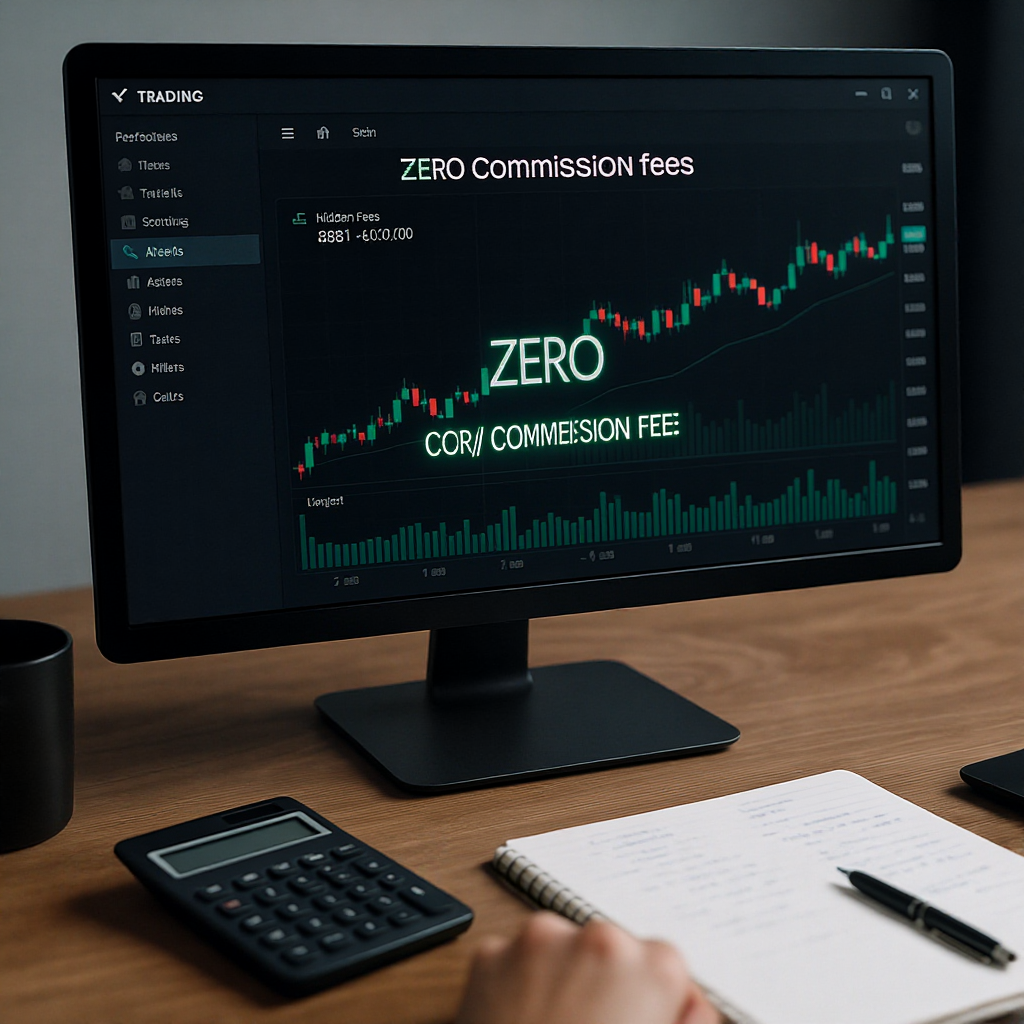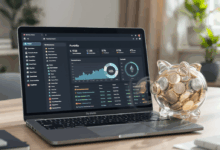Master Low-Fee Trading Platforms – Navigate the Market Without Breaking the Bank

Have you ever paused before clicking “buy” or “sell” because the fees lurking in the background made you hesitate? I know I have—wondering if the platform’s promises really match the fine print. It’s fascinating how the idea of “free trading” has become almost standard, yet beneath the surface, costs can still creep in unexpectedly.
Take Robinhood, for instance. Its commission-free model has drawn millions, but recent investigations hint at a more complicated story behind those low costs. It makes me think—are we truly getting the “lowest fees,” or just a clever marketing illusion? This tension between what’s advertised and what actually impacts your wallet feels like an ongoing puzzle for every investor.
The world of trading platforms is shifting rapidly. You’re no longer confined to just one choice; a variety of services now compete with zero commissions, but each comes with its own quirks—advanced trading tools, customer support options, or subtle fees like inactivity or transfer charges. Could it be that the “lowest fee” isn’t just about the number zero in commissions but about the whole package?
In this piece, we’ll explore the real landscape behind low-fee trading platforms: the evolving features that matter, the hidden costs to watch for, and how to balance your needs as a trader. If you’ve ever felt overwhelmed by comparing platforms or unsure whether a “free” trade is truly free, this guide might help clear the fog and give you a clearer path.
Imagine having a straightforward process to evaluate platforms—not just chasing the lowest headline fee but understanding the trade-offs and benefits. That’s what we aim to uncover together. So, what exactly should you look for beyond the zero commission tag? How can you avoid surprises and make the most of your investments without paying a premium?
Let’s dive into the changing world of trading costs and tools, and see how you can navigate it wisely. What do you think—is it time to rethink what “low fees” really mean for your trading journey?
Navigating the Maze What Does “Lowest Fees” Really Mean?
I still remember the first time I tried to pick a trading platform. The promise of “commission-free” trades sounded like music to my ears. But soon enough, I found myself tangled in a web of other fees—transfer charges, inactivity penalties, margin costs—that weren’t so obvious at first glance. It’s like stepping into a store where everything is labeled “free,” but the cashier slips in a surcharge you only notice when you get the receipt.
This experience made me wonder: When we talk about “trading platforms with the lowest fees and commissions,” are we truly comparing apples to apples? Or are some platforms just better at marketing their “free” services, while quietly charging elsewhere?
Beyond Zero Commission The Full Cost Picture
The landscape as of mid-2025 is fascinating. Platforms like Robinhood and Webull have made zero-commission trading their flagship feature. That’s a game-changer for frequent traders who dread fees eating up their profits. But as I dug deeper, I found that zero commission doesn’t mean zero cost.
For example, inactivity fees or fees for transferring your account to another broker can quietly add up. Charles Schwab charges $75 for outgoing transfers, which might surprise those switching platforms without doing their homework. Margin rates—interest paid on borrowed money to trade—also vary, impacting your overall cost if you leverage.
So, it’s essential to evaluate the entire fee structure, not just the headline commission. Think of it like buying a car: the sticker price might be low, but the maintenance, insurance, and fuel costs shape the true ownership expense.
Tools and Features Are They Worth the Cost?
Another layer to consider is what you get beyond just low trading fees. Platforms such as ETRADE with its “Power ETRADE” and Charles Schwab’s “thinkorswim” offer advanced charting, real-time data, and customizable layouts. For a beginner, these might feel overwhelming, yet for an active trader, they can be invaluable.
Reflecting on this, I ask myself: Should the “lowest fee” platform also offer robust tools and support? Or is it better to sacrifice some features for cheaper trades? I guess it depends on your trading style and goals. If you’re just starting or trading occasionally, a simple, low-cost platform might suffice. But for those delving deeper, investing in a platform with advanced resources could pay off.
Hidden Costs and Regulatory Transparency
Interestingly, recent regulatory scrutiny, such as the Florida Attorney General’s probe into Robinhood Crypto, highlights how murky fee structures can be. Transparency matters—not just for compliance but for your peace of mind.
Platforms might advertise “free” trading, but sometimes the way they make money is through payment for order flow or other practices that could affect execution quality. This makes me think: Are we trading for free, or is the cost hidden somewhere else?
A Practical Approach: How to Choose Wisely
So, how can you, as an investor, navigate this complexity? Here’s a step-by-step approach I found helpful:
-
Step 1: List Your Priorities. Are low commissions your top concern, or do you value advanced tools and customer service more? Knowing your needs will guide your choice.
-
Step 2: Analyze Fee Schedules. Don’t just look at commissions. Check for account fees, inactivity penalties, transfer charges, margin rates, and any other costs.
-
Step 3: Test the Platform. Many platforms offer demo accounts or free trials. Use them to get a feel for the interface and tools.
-
Step 4: Research Customer Support. See if the platform offers timely and helpful support. Good service can save you headaches later.
-
Step 5: Stay Updated on Regulatory News. Platforms evolve; keeping an eye on investigations or changes helps avoid surprises.
A Real-World Scenario
Imagine you’re an occasional trader who values simplicity and low cost. You might lean toward Robinhood or Webull for zero commissions. But if you trade frequently and need detailed analytics, E*TRADE or Charles Schwab might serve better despite slightly higher fees.
Also, consider future needs. Freetrade’s recent acquisition by IG Group hints at possible fee or service changes. Being adaptable and informed is key.
What Do You Think?
Does “lowest fees” mean the same to all of us? Or is it a personal equation balancing cost, tools, support, and transparency? I’m curious—how do you weigh these factors when choosing a platform? Could a slightly higher fee be worth it for better resources? Or does every penny count toward your strategy?
As we continue to explore this, maybe it’s not about finding the “perfect” platform but about understanding your unique trading journey and selecting the best companion for it. After all, in trading—as in life—the path matters as much as the destination.
Ready to take the next step? In the following section, let’s break down how to practically evaluate and compare trading platforms, with concrete tips and pitfalls to watch out for.

Reflecting on our journey through the maze of trading platforms, it becomes clear that the quest for the “lowest fees and commissions” is far more nuanced than a simple zero on the price tag. We’ve uncovered how hidden costs—like inactivity fees, transfer charges, and margin rates—can quietly reshape the real expense of trading. Beyond fees, the value of tools, customer support, and transparency emerges as a vital part of this equation, reminding us that the “cheapest” isn’t always the smartest choice. This ultimately means that choosing a platform is less about chasing an elusive perfect deal and more about understanding your personal trading style and priorities within a dynamic landscape.
With this understanding, you’ve gained the power to look beyond marketing catchphrases and ask the right questions: What costs truly matter to me? Which features will support my growth as a trader? How can I stay vigilant about changing platform policies? These insights are your compass.
So, what can you do next? Start by listing your own trading priorities—are low commissions your top concern, or do you lean toward robust tools and responsive support? Dive into fee schedules beyond commissions and test platforms through demos or trial accounts. Keep an eye on regulatory news and customer experiences to avoid surprises. Remember, this process isn’t a one-time event but an ongoing conversation with your investment goals.
Looking ahead, as trading platforms continue to evolve—merging, innovating, or adjusting fees—the ability to adapt and critically evaluate will become even more essential. We might see new models that redefine “low cost” again, or regulations that bring greater clarity. Staying curious and informed will keep you a step ahead.
In the end, isn’t this what makes trading more than just numbers? It’s a personal journey, where every choice reflects your values and ambitions. So, what do you think—how will you navigate your path in this shifting terrain? If this exploration has sparked new questions or perspectives, take that as a sign: your trading story is just beginning.
Now, why not take the first step today? Try out a platform demo, scrutinize a fee schedule, or simply jot down your priorities. Each small action builds your confidence and sharpens your strategy. After all, the best way to master the art of low-fee trading is to engage with it directly. What will your next move be?

